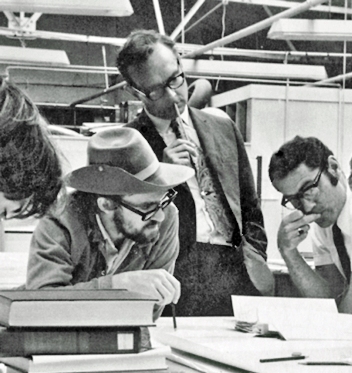 Geologist with Hunting Geology & Geophysics who worked on major mapping projects in Africa and Middle East.
Geologist with Hunting Geology & Geophysics who worked on major mapping projects in Africa and Middle East.
John Crook's career reveals a well-regarded geologist, who worked from 1955 on major geological mapping projects in Africa and the Middle East. From 1972 until 1990 he was deeply involved in research on, and the utilisation of, the increasing information becoming available from satellites and the development of remote sensing.
John (pictured, standing) graduated in 1955 from the then Kingston Technical College, with a 1st Class Honours Geology Degree. He became a Junior Associate of the Geological Society in 1952 and was elected Fellow on 23 November 1955.
In 1955, John married Rosemary Smithers, and they spent the next 10 years in Ghana. John's field mapping was in the Volta region for the Geological Survey of Ghana. His maps and reports were published by the Survey and also reported in The Mineral and Rock Resources of Ghana, by G O Kese. John also contributed to the papers of Richard Holm on the Dahomeyan gneiss in the western Accra Plains, Ghana.
The opportunity to join Hunting Geology and Geophysics Ltd arose in 1966. Huntings had been established in 1952 and provided an increasingly wide range of services to oil and mining companies, the United Nations and governments. John was an important leader of many teams, and in time was appointed an Associate Director.
To illustrate John's work I have selected just two projects, which demonstrate his wide experience and managerial skills.
In 1977, Huntings were awarded the contract to undertake geological mapping and mineral exploration in three large areas of basement rock in southern Libya. Since there were no maps or roads in the area Huntings resorted to using the earliest ERTS (now Landsat) imagery to navigate across the Sahara. This was a typical large-scale project where the Hunting's geologists were responsible for not only the technical work but also overcoming massive logistic problems. In such projects John provided essential support and was a friend and mentor to many geologists.
It is a measure of John's modesty that he didn't talk of himself and never complained of difficulties in the field, in spite of bouts of serious migraine. He had a fantastic sense of fun and humour. Almost every day he had a joke to tell to lift the mood, whatever the circumstance. His honesty and selflessness and kindness to all brought out the best in all who worked with him. He made everyone feel part of the team and always offered careful considered advice and help with our tasks, however much we needed to know.
In November 1985, Huntings were awarded the contract to support the NRSC in its mission to promote the use of remote sensing in Britain and by British companies working overseas. It did this by undertaking pilot projects using remote sensing in agriculture, geology, oceanography, forestry, urban planning and disaster monitoring, testing and planning for new sensors.
John Crook was appointed Project Manager, and managed a team of scientists together with support staff. The team became widely respected in the industry, and broke new ground in many fields, for example: using multi-band thermal imagery in geology, and monitoring opencast mines, oil slicks and bush fires. John was a humorous, calm and fairly ‘hands-off’ but very supportive manager of the project. The project continued to the end of 1990.
Subsequently John and Rosemary retired to Harrogate in Yorkshire. John is survived by his widow Rosemary, their two children, Andrew and Susan, and five grandchildren.
Derek Morris